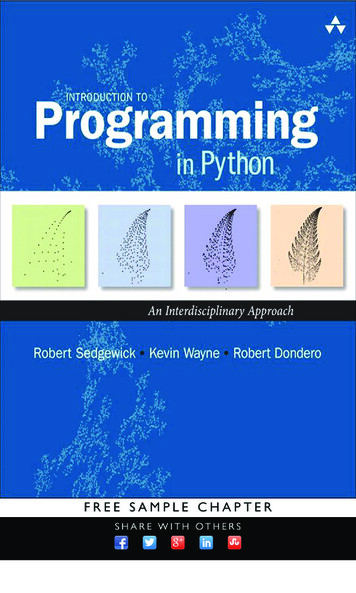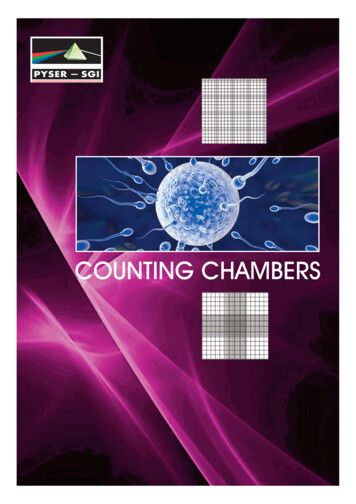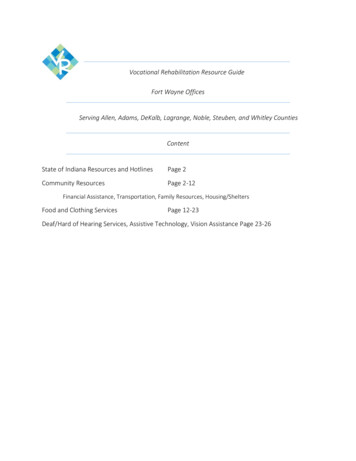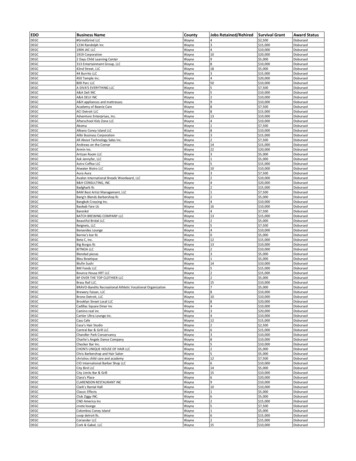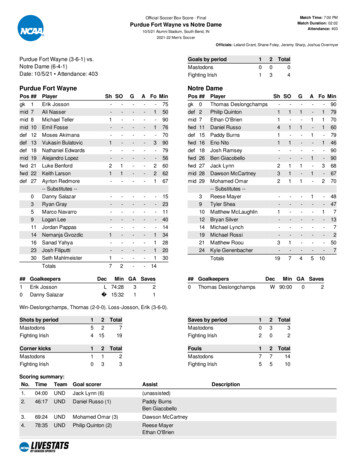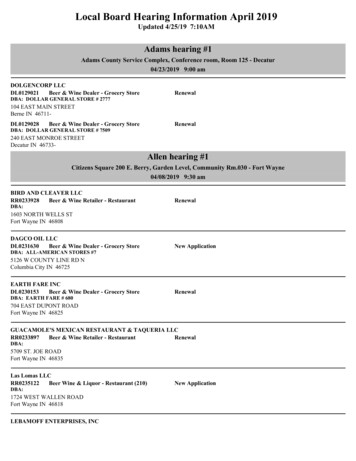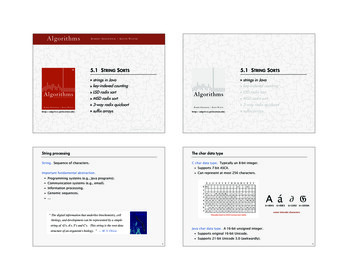
Transcription
AlgorithmsAlgorithmsF O U R T HE D I T I O NR OBERT S EDGEWICK K EVIN W AYNEhttp://algs4.cs.princeton.eduR OBERT S EDGEWICK K EVIN W AYNE5.1 S TRING S ORTS5.1 S TRING S ORTS‣ strings in Java‣ key-indexed counting‣ strings in Java‣ key-indexed counting‣ LSD radix sort‣ LSD radix sortAlgorithms‣ MSD radix sort‣ 3-way radix quicksort‣ MSD radix sort‣ 3-way radix quicksortR OBERT S EDGEWICK K EVIN W AYNE‣ suffix arrays‣ suffix arrayshttp://algs4.cs.princeton.eduLast updated on 4/25/16 2:27 PMString processingThe char data typeString. Sequence of characters.C char data type. Typically an 8-bit integer.Important fundamental abstraction.・Supports 7-bit ASCII.Data Compression 667・Can represent at most 256 characters.6.5・Programming systems (e.g., Java programs).・Communication systems (e.g., email).・Information processing.・Genomic sequences.・ “ The digital information that underlies biochemistry, cellbiology, and development can be represented by a simplestring of G's, A's, T's and C's. This string is the root datastructure of an organism's biology. ” — M. V. Olson0nASCII encoding. When you HexDump a bit0 1 2 3 4 5 6 7 8 9 A B C D E Fstream that contains ASCII-encoded charac- 0 NUL SOH STX ETX EOT ENQ ACK BEL BS HT LF VT FF CR SO SIters, the table at right is useful for reference. 1 DLE DC1 DC2 DC3 DC4 NAK SYN ETB CAN EM SUB ESC FS GS RS USGiven a 2-digit hex number, use the first hex 2 SP ! “ # % & ‘ ( ) * , - . /digit as a row index and the second hex digit 3 0 1 2 3 4 5 6 7 8 9 : ; ?as a column reference to find the character 4 @ A B C D E F G H I J K L M N Othat it encodes. For example, 31 encodes the 5 P Q R S T U V W X Y Z [ \ ] digit 1, 4A encodes the letter J, and so forth. 6 a b c d e f g h i j k l m n oThis table is for 7-bit ASCII, so the first hex 7 p q r s t u v w x y z { } DELdigit must be 7 or less. Hex numbers startingHexadecimal to ASCII conversion tablewith 0 and 1 (and the numbers 20 and 7F)correspond to non-printing control characters. Many of the control characters are left over from the days when physical deviceslike typewriters were controlled by ASCII input; the table highlights a few that youchardata type.Anull16-bitunsignedinteger.might see in dumps. For example SP isJavathe spacecharacter,NUL is thecharacter,LFis line-feed, and CR is carriage-return.Supports original 16-bit Unicode.U 0041U 00E1U 2202U 1D50Asome Unicode ).In summary, working with data compressionrequires us toreorientour thinkingaboutstandard inputand standard output to include binary encoding of data. BinaryStdIn3and BinaryStdOut provide the methods that we need. They provide a way for you tomake a clear distinction in your client programs between writing out information intended for file storage and data transmission (that will be read by programs) and printing information (that is likely to be read by humans).4
5I Unicode6The String data typeString data type in Java. Immutable sequence of characters.Length. Number of characters.Indexing. Get the ith character.Concatenation. Concatenate one string to the end of another.s.length()s0123456789 10 11 12ATTACKATDAWNs.charAt(3)U 0041Fundamental constant-time String operations78
THE STRING DATA TYPE:The String data type: representationIMMUTABILITYRepresentation (Java 7). Immutable char[] array cache of hash.Q. Why are Java strings immutable?A. All the usual reasons.・Provides security.・Ensures consistent state.・Can use as keys in symbol table.・Removes need to defensively copy.・Supports concurrency / thread safety.・Simplifies tracing and debugging code.・Enables compiler to perform certain optimizations.・ operationJavarunning tions tM N Q. Could concatenation be O(1)?A. Yes, but charAt would no longer be.Immutable strings. Java, C#, Python, Scala, .Mutable strings. C, C , Matlab, Ruby, 910String performance trapComparing two stringsQ. How to build a long string, one character at a time?Q. How many character compares to compare two strings, each of length W ?s.compareTo(t)public static String reverse(String s){String reverse "";for (int i s.length() - 1; i 0; i--)rev s.charAt(i);return reverse;squadratic time(1 2 3 N)tprefetc0123456h7prefixes}A.Use StringBuilder data type (mutable char[] resizing array).Running time. Proportional to length of longest common prefix.・Proportional to W in the worst case.・But, often sublinear in W.public static String reverse(String s){StringBuilder reverse new StringBuilder();for (int i s.length() - 1; i 0; i--)reverse.append(s.charAt(i));return reverse.toString();linear time}1112
The String data type: Java 7u5 implementationThe String data type: Java 7u6 implementationpublic final class String implements Comparable String public final class String implements Comparable String {{private char[] value;// charactersprivate char[] value;// charactersprivate int offset;private int length;// index of first char in array// length of stringprivate int hash; // cache of hashCode()private int hash; // cache of hashCode()String s "Hello, World"String s "Hello, World"length 345WORLD012346WORLD7891011offset 0length 5String t s.substring(7, 12);value[]HELLO,0123456String t s.substring(7, 12);WORLD7891011offset 7value[]13The String data type: performance14A Reddit exchangeString data type (in Java). Sequence of characters (immutable).Java 7u5. Immutable char[] array, offset, length, hash cache.I'm the author of the substring() change. As hasJava 7u6. Immutable char[] array, hash cache.been suggested in the analysis here there were twomotivations for the change Reduce the size of String instances. Stringsare typically 20-40% of common apps footprint.operationJava 7u5Java 7u6length11indexing11substring extraction1NconcatenationM NM Nimmutable? Avoid memory leakage caused by retainedbondolosubstrings holding the entire character array.memoryChanging this function, in a bugfix release noless, was totally irresponsible. It broke backwardscompatibility for numerous applications with errorsthat didn't even produce a message, just freezingand timeouts.All pain, no gain. Your work wasnot just vain, it was thoroughly destructive, even64 2N56 2Ncypherpunksbeyond its immediate s/1qw73v/til oracle changed the internal string1516
AlphabetsDigital key. Sequence of digits over fixed alphabet.604CHAPTER 6!StringsRadix. Number of digits R in UVWXYZabcdefghijklmnopqrstuvwxyz0123456789 /ASCII1287ASCII charactersEXTENDED ASCII2568extended ASCII charactersUNICODE166553616Unicode characters5.1 S TRING S ORTS‣ strings in Java‣ key-indexed countingAlgorithmsR OBERT S EDGEWICK K EVIN W AYNEhttp://algs4.cs.princeton.edu‣ LSD radix sort‣ MSD radix sort‣ 3-way radix quicksort‣ suffix arraysStandard alphabetsholds the frequencies in Count is an example of a character-indexed array. With a JavaString, we have to use an array of size 256; with Alphabet, we just need an array withone entry for each alphabet character. This savings might seem modest, but, as you willsee, our algorithms can produce huge numbers of such arrays, and the space for arraysof size 256 can be prohibitive.17Numbers. As you can see from our several of the standard Alphabet examples, we of-represent numbers as strings. The methods toIndices() coverts any String overProgramtenoptimizationReview: summary of the performance of sorting algorithmsa given Alphabet into a base-R number represented as an int[] array with all valuesbetween 0 and R!1. In some situations, doing this conversion at the start leads to compact code, because any digit can be used as an index in a character-indexed array. Forexample, if we know that the input consists only of characters from the alphabet, wecould replace the inner loop in Count with the more compact codeFrequency of operations.int[] a alpha.toIndices(s);for (int i 0; i N; i )count[a[i]] ;“ The first rule of program optimization: don't do it.The second rule of program optimization (for experts only!):don't do it yet. ” – Michael A. Jacksonalgorithmguaranteerandomextra spacestable?operations on keysinsertion sort½ N2¼ N21 compareTo()mergesortN lg NN lg NN compareTo()quicksort1.39 N lg N *1.39 N lg Nc lg N *compareTo()heapsort2 N lg N2 N lg N1compareTo()* probabilisticLower bound. N lg N compares required by any compare-based algorithm.Q. Can we do better (despite the lower bound)?A. Yes, if we don't depend on key compares.19use array accessesto make R-way decisions(instead of binary decisions)20
Key-indexed counting: assumptions about keysStably sorting a set of cards by suitAssumption. Keys are integers between 0 and R - 1.Implication. Can use key as an array index.inputApplications.・Sort string by first letter.・Sort class roster by section.・Sort phone numbers by area code.・Subroutine in a sorting algorithm. [stay tuned]Remark. Keys may have associated data can't just count up number of keys of each value.sorted resultnamesectionAnderson artin1Martinez 2Miller2Moore1Robinson 2Smith4Taylor3Thomas4Thompson 4White2Williams 3Wilson4(by 4444We want clubs, then diamonds, hearts, spadesStability: within each suit, same order as originalkeys aresmall integersTypical candidate for key-indexed counting21Stably sorting a set of cards by suit22Stably sorting a set of cards by es36SuitNextposClubs0Diamonds2Hearts3Spades6Count the number of cards in each suitMove cards into final position one by oneUse this to calculate starting position of each suit in sorted order2324
Stably sorting a set of cards by suitStably sorting a set of cards by monds2Hearts3Hearts3Spades6Spades625Stably sorting a set of cards by suit26Stably sorting a set of cards by monds2Hearts3Hearts4Spades6Spades62728
Stably sorting a set of cards by suitStably sorting a set of cards by monds3Hearts4Hearts4Spades6Spades629Stably sorting a set of cards by suit30Stably sorting a set of cards by monds3Hearts4Hearts5Spades6Spades63132
Stably sorting a set of cards by suitStably sorting a set of cards by monds3Hearts5Hearts5Spades6Spades733Stably sorting a set of cards by suit34Stably sorting a set of cards by monds3Hearts5Hearts6Spades7Spades73536
Stably sorting a set of cards by suitStably sorting a set of cards by monds3Hearts6Hearts6Spades7Spades837Stably sorting a set of cards by suit38Stably sorting a set of cards by monds3Hearts6Hearts6Spades8Spades93940
Stably sorting a set of cards by suitKey-indexed al. Sort an array a[] of N integers between 0 and R - 1.・Count frequencies of each letter using key as index.・Compute frequency cumulates which specify destinations.・Access cumulates using key as index to move items.・Copy back into original array.int N a.length;int[] count new int[R];int[] pos new int[R];for (int i 0; i N; i )count[a[i]] ;for (int r 1; r R; r )pos[r] count[r-1] pos[r-1];for (int i 0; i N; i )aux[pos[a[i]] ] a[i];for (int i 0; i N; i )a[i] aux[i];4142Key-indexed countingKey-indexed countingGoal. Sort an array a[] of N integers between 0 and R - 1.Goal. Sort an array a[] of N integers between 0 and R - 1.・Count frequencies of each letter using key as index.・Compute frequency cumulates which specify destinations.・Access cumulates using key as index to move items.・Copy back into original array.・Count frequencies of each letter using key as index.・Compute frequency cumulates which specify destinations.・Access cumulates using key as index to move items.・Copy back into original array.int N a.length;int[] count new int[R];int[] pos new int[R];for (int i 0; i N; i )count[a[i]] ;Q. Modify this code to sort an arrayint N a.length;int[] count new int[R];int[] pos new int[R];a[] of Objects, assuming a key()method that returns int between0 and R-1.for (int i 0; i N; i )count[a[i].key() 1] ;for (int r 1; r R; r )Q. Modify this code to sort an arraya[] of Objects, assuming a key()method that returns int between0 and R-1.for (int r 1; r R; r )pos[r] count[r-1] pos[r-1];pos[r] count[r-1] pos[r-1];for (int i 0; i N; i )for (int i 0; i N; i )aux[pos[a[i]] ] a[i];aux[pos[a[i].key()] ] a[i];for (int i 0; i N; i )a[i] aux[i];for (int i 0; i N; i )a[i] aux[i];4344
Radix sorting: quiz 1Which of the following are properties of key-indexed counting?A.Running time proportionalN i R.0;for to(intB.Extra space proportional to N R.C.Stable.D.All of the above.E.I don't know.i N; i )aux[count[a[i].key(d)] ] a[i];1000001111222333333333count[]2 3 43 8 144 8 144 9 144 10 144 10 154 10 154 11 154 11 164 12 164 12 165 12 166 12 166 12 167 12 167 12 177 13 177 13 187 13 198 13 198 14 198 14 ThompsonWilson111222223333334444445.1 S TRING S ORTSaux[0]aux[1]aux[2]‣ strings in Java‣ key-indexed countingaux[3]aux[4]aux[5]aux[6]‣ LSD radix sortAlgorithmsaux[7]aux[8]aux[9]‣ MSD radix sortaux[10]aux[11]aux[12]‣ 3-way radix quicksortR OBERT S EDGEWICK K EVIN W AYNEaux[13]‣ suffix ux[16]aux[17]aux[18]aux[19]Distributing the data (records with key 3 highlighted)45Recall from midtermLeast-significant-digit-first string sortWe can sort an array by date by first sorting it by day, then by month, thenLSD string (radix) sort.by year, but only if we use a stable sorting algorithm.・Consider characters from right to left.・Stably sort using d character as the key (using key-indexed counting).thsort key (d 2)yyyymmddyyyymmddyyyyyyyyyyyymmmmmmddddddsort key (d 1)sort key (d eesort is stable(arrows do not cross)4748
LSD string sort: correctness proofLSD string sort: Java implementationProposition. LSD sorts fixed-length strings in ascending order.sort keyPf. [ by induction on i ]after pass iAfter pass i, strings are sorted by last i characters.0・If two strings differ on sort key,dab01cab2fad3barelative order.4dIf two strings agree on sort key,5stability keeps them in proper relative order.key-indexed sort puts them in 7dad8fed8ebb9bed9fad10fee10fed11bee11feepublic class LSD{public static void sort(String[] a, int W){int R 256;int N a.length;String[] aux new String[N];for (int d W-1; d 0; d--){int[] count new int[R 1];for (int i 0; i N; i )count[a[i].charAt(d) 1] ;for (int r 0; r R; r )count[r 1] count[r];for (int i 0; i N; i )aux[count[a[i].charAt(d)] ] a[i];for (int i 0; i N; i )a[i] aux[i];}Proposition. LSD sort is stable.do key-indexed countingfor each digit from right to leftkey-indexed counting}sorted fromPf. Key-indexed counting is stable.fixed-length W stringsradix Rprevious passes}(by induction)4950Summary of the performance of sorting algorithmsRadix sorting: quiz 2Frequency of operations.Which sorting method to use to sort 1 million 32-bit integers?algorithmguaranteerandomextra spacestable?A.Insertion sort.B.Mergesort.operations on keys01110110111011011101.1011101insertion sort½ N2¼ N21 compareTo()C.Quicksort.mergesortN lg NN lg NN compareTo()D.LSD radix sort.E.I don't know.quicksortheapsortLSD sort†1.39 N lg Nc lg NcompareTo()2 N lg N2 N lg N1compareTo()2 W (N R)2 W (N R)N R1.39 N lg N* charAt()* probabilistic† fixed-length W keysQ. What if strings are not all of same length?5152
String sorting interview questionSORT ARRAY OF 128-BIT NUMBERSProblem. Sort huge array of random 128-bit numbers.Ex. Supercomputer sort, internet router.01110110111011011101.1011101Which sorting method to use?・Insertion sort.・Mergesort.・Quicksort.・Heapsort.・LSD string sort.Google CEO Eric Schmidt interviews Barack Obama5354SORT ARRAY OF 128-BIT NUMBERSSORT ARRAY OF 128-BIT NUMBERSProblem. Sort huge array of random 128-bit numbers.Ex. Supercomputer sort, internet router.Problem. Sort huge array of random 128-bit numbers.Ex. Supercomputer sort, internet router.01110110111011011101.1011101Which sorting method to use?01110110111011011101.1011101Which sorting method to use?・・Mergesort.・Quicksort.・Heapsort. ・LSD string sort.・Insertion sort.・Mergesort.・Quicksort.・Heapsort. ・LSD string sort. Insertion sort.Divide each word into eight 16-bit “chars”Divide each word into eight 16-bit “chars”216 65,536 counters.Sort in 8 passes.216 65,536 countersLSD sort on leading 32 bits in 2 passesFinish with insertion sortExamines only 25% of the data5556
How to take a census in 1900s?How to get rich sorting in 1900s?1880 Census. Took 1500 people 7 years to manually process data.Punch cards. [1900s to 1950s]Herman Hollerith. Developed a tabulating and sorting machine.・Also useful for accounting, inventory, and business processes.・Primary medium for data entry, storage, and processing.・Use punch cards to record data (e.g., sex, age).・Machine sorts one column at a time (into one of 12 bins).・Typical question: how many women of age 20 to 30?Hollerith tabulating machine and sorterHollerith's company later merged with 3 others to form ComputingTabulating Recording Corporation (CTRC); company renamed in 1924.punch card (12 holes per column)1890 Census. Finished in 1 year (and under budget)!IBM 80 Series Card Sorter (650 cards per minute)5758LSD string sort: a moment in history (1960s)5.1 S TRING S ORTScard punchpunched cardscard readermainframeline printer‣ strings in Java‣ key-indexed countingnot directly relatedto sortingTo sort a card deck- start on right columnAlgorithms- put cards into hopper- machine distributes into bins- pick up cards (stable)R OBERT S EDGEWICK K EVIN W AYNE- move left one columnhttp://algs4.cs.princeton.edu- continue until sortedcard sorterLysergic Acid Diethylamide(Lucy in the Sky with Diamonds)59‣ LSD radix sort‣ MSD radix sort‣ 3-way radix quicksort‣ suffix arrays
Reverse LSDMost-significant-digit-first string sort・Consider characters from left to right.・Stably sort using d character as the key (using key-indexed counting).MSD string (radix) sort.・Partition array into R pieces according to first characterth(use key-indexed counting).sort key (d 0)sort key (d 1)・Recursively sort all strings that start with each charactersort key (d 2)(key-indexed counts delineate subarrays to 0feenot sorted!11ace11fedsort key61MSD string sort: urelythethefadfee11fed62Variable-length stringsTreat strings as if they had an extra char at end (smaller than any ellsaresurelyseashells910sort ssellssheshoreshellsshesurelythetheneed to examineevery characterin equal keysarearearearebybybybyseaseaseaseaseashells seashells seashells seashellsseashells seashells seashells relythetheend of stringgoes before anychar valuearearearebybybyseaseaseaseashells seashells seashellsseashells seashells lssellssellssheshoreshellsshesurelythethewhy hore-17surelylls-1she before lsshesheshellsshoresurelythetheprivate static int charAt(String s, int d){if (d s.length()) return s.charAt(d);else return -1;}C strings. Have extra char '\0' at end no extra work needed.Trace of recursive calls for MSD string sort (no cutoff for small subarrays, subarrays of size 0 and 1 omitted)6364
MSD string sort: Java implementationMSD string sort: potential for disastrous performancecount[]Observation 1. Much too slow for small subarrays.public static void sort(String[] a){・Each function call needs its own count[] array.・ASCII (256 counts): 100x slower than copy pass for N 2.・Unicode (65,536 counts): 32,000x slower for N 2.recycles aux[] arraybut not count[] arrayaux new String[a.length];sort(a, aux, 0, a.length - 1, 0);}Observation 2. Huge number of small subarraysprivate static void sort(String[] a, String[] aux, int lo, int hi, int d){if (hi lo) return;int[] count new int[R 2];key-indexed countingfor (int i lo; i hi; i )count[charAt(a[i], d) 2] ;for (int r 0; r R 1; r )count[r 1] count[r];because of recursion.for (int i lo; i hi; i )aux[count[charAt(a[i], d) 1] ] a[i];for (int i lo; i hi; i )a[i] aux[i - lo];for (int r 0; r R; r )sort R subarrays recursivelysort(a, aux, lo count[r], lo count[r 1] - 1, d 1);a[]}65Cutoff to insertion sortaux[]0b0a1a1b66MSD string sort: performanceSolution. Cutoff to insertion sort for small subarrays.Number of characters examined.・Insertion sort, but start at d・MSD examines just enough characters to sort the keys.・Number of characters examined depends on keys.・Can be sublinear in input size!thcharacter.private static void sort(String[] a, int lo, int hi, int d){for (int i lo; i hi; i )for (int j i; j lo && less(a[j], a[j-1], d); j--)exch(a, j, j-1);}・Implement less() so that it compares starting at dthcompareTo() based sortscan also be sublinear!character.private static boolean less(String v, String w, int d){for (int i d; i Math.min(v.length(), w.length()); i ){if (v.charAt(i) w.charAt(i)) return true;if (v.charAt(i) w.charAt(i)) return false;}return v.length() minedexaminedbybyMSDMSDstringstringsortsort}6768
Summary of the performance of sorting algorithmsMSD string sort vs. quicksort for stringsFrequency of operations.Disadvantages of MSD string sort.algorithmguaranteerandomextra spacestable?operations on keysinsertion sort½ N2¼ N21 compareTo()mergesortN lg NN lg NN compareTo()quicksort1.39 N lg N *1.39 N lg Nc lg N *compareTo()heapsort2 N lg N2 N lg N1compareTo()・Extra space for aux[].・Extra space for count[].・Inner loop has a lot of instructions.・Accesses memory "randomly" (cache inefficient).Disadvantage of quicksort.LSD sort†2 W (N R)2 W (N R)N R charAt()MSD sort‡2 W (N R)N log R NN DR charAt()・Linearithmic number of string compares (not linear).・Has to rescan many characters in keys with long prefix matches.doesn't rescancharacterstight inner loop,cache friendly* probabilistic† fixed-length W keysD function-call stack depth(length of longest prefix match)‡ average-length W keysGoal. Combine advantages of MSD and quicksort.6970Engineering a radix sort (American flag sort)Optimization 0. Cutoff to insertion sort.Optimization 1. Replace recursion with explicit stack.・Push subarrays to be sorted onto stack.・One count[] array now suffices.Optimization 2. Do R-way partitioning in place.・Eliminates aux[] array.・Sacrifices stability.American national flag problemDutch national flag problem5.1 S TRING S ORTS‣ strings in Java‣ key-indexed countingEngineering Radix SortPeterM. Mcllroy and Keith BosticUniversity of California at Berkeley;andM. Douglas McllroyAlgorithmsAT&T Bell LaboratoriesABSTRACT Radix sorting methods have excellentasymptotic performance on string data, for which comparison is not a unit-time operation. Attractive for usein large byte-addressable memories, these methodshave nevertheless long been eclipsed by more easilyprograÍrmed algorithms. Three ways to sort strings bybytes left to right-a stable list sort, a stable two-arraysort, and an in-place "American flag" sor¿-are illustrated with practical C programs. For heavy-duty sorting, all three perform comparably, usually running atleast twice as fast as a good quicksort. We recommendAmerican flag sort for general use.R OBERT S EDGEWICK K EVIN W AYNEhttp://algs4.cs.princeton.edu71@Computing Systems, Vol. 6. No. 1 . Winter 1993‣ LSD radix sort‣ MSD radix sort‣ 3-way radix quicksort‣ suffix arrays
3-way string quicksort (Bentley and Sedgewick, 1997)3-way string quicksort: trace of recursive callspartitioning itemOverview. Do 3-way partitioning on the dth character.・Less overhead than R-way partitioning in MSD radix sort.・Does not re-examine characters equal to the partitioning char.(but does re-examine characters not equal to the partitioning char)partitioning itemuse first character topartition into"less", "equal", and cursively sort subarrays,excluding first characterfor middle thethethetheseashellsthethethetheTrace of first few recursive calls for 3-way string quicksort (subarrays of size 1 not shown)733-way string quicksort: Java implementation743-way string quicksort vs. standard quicksortStandard quicksort.・Uses 2 N ln N string compares on average.・Costly for keys with long common prefixes (and this is a common case!)private static void sort(String[] a){ sort(a, 0, a.length - 1, 0); }private static void sort(String[] a, int lo, int hi, int d){if (hi lo) return;3-way partitioningint lt lo, gt hi;(using dth character)int v charAt(a[lo], d);int i lo 1;while (i gt)to handle variable-length strings{int t charAt(a[i], d);if(t v) exch(a, lt , i );3-way string (radix) quicksort.・Uses 2 N ln N character compares on average for random strings.・Avoids re-comparing long common prefixes.Fast Algorithms for Sorting and Searching Stringselse if (t v) exch(a, i, gt--);elsei ;Jon L. Bentley*}sort(a, lo, lt-1, d);if (v 0) sort(a, lt, gt, d 1);sort(a, gt 1, hi, d);Abstractsort 3 subarrays recursively}75We present theoretical algorithms for sorting andsearching multikey data, and derive from them practical Cimplementations for applications in which keys are character strings. The sorting algorithm blends Quicksort andradix sort; it is competitive with the best known C sortcodes. The searching alg
Digital key. Sequence of digits over fixed alphabet. Radix. Number of digits R in alphabet. Alphabets 17 604 CHAPTER 6 ! Strings holds the frequencies in Count is an example of a character-indexed array. With a Java String, we have to use an array of size 256; with Alphabet, we just need an array with one entry for each alphabet character.
